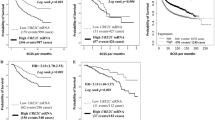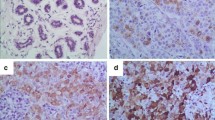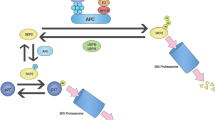Abstract
Purpose
The ubiquitin C-terminal hydrolase L1 (UCH-L1) belongs to the family of deubiquitinating enzymes. It is overexpressed in various tumour entities and associated with metastases formation in some solid tumours. However, only limited information about its role in breast cancer is available. The aim of this study was to examine the UCH-L1 expression in primary breast cancer and to determine its relevance as a potential prognostic marker.
Methods
We investigated both UCH-L1 mRNA expression in microarray data from 182 primary mammary carcinomas and UCH-L1 protein expression using a tissue microarray containing samples from 1,622 breast cancer patients.
Results
With both methods, high UCH-L1 expression correlated significantly with negative oestrogen receptor and progesterone receptor status and advanced tumour stage. Moreover by Kaplan–Meier analysis, high UCH-L1 mRNA and protein expression correlated with a significantly shorter overall survival.
Conclusion
The data of our study suggest that high levels of UCH-L1 expression indicate a more aggressive tumour behaviour and might represent a potential target in breast cancer treatment.




Similar content being viewed by others
References
Akishima-Fukasawa Y, Ino Y, Nakanishi Y, Miura A, Moriya Y, Kondo T, Kanai Y, Hirohashi S (2010) Significance of PGP9.5 expression in cancer-associated fibroblasts for prognosis of colorectal carcinoma. Am J Clin Pathol 134(1):71–79. doi: 10.1309/AJCPRJP39MIDSGBH
Doran JF, Jackson P, Kynoch PA, Thompson RJ (1983) Isolation of PGP 9.5, a new human neurone-specific protein detected by high-resolution two-dimensional electrophoresis. J Neurochem 40(6):1542–1547
Elston CW, Ellis IO (1991) Pathological prognostic factors in breast cancer I. The value of histological grade in breast cancer: experience from a large study with long-term follow-up. Histopathology 19(5):403–410
Fang Y, Fu D, Shen XZ (2010) The potential role of ubiquitin c-terminal hydrolases in oncogenesis. Biochim Biophys Acta 1:1–6. doi:10.1016/j.bbcan.2010.03.001
Hayes DF, Bast RC, Desch CE, Fritsche H Jr, Kemeny NE, Jessup JM, Locker GY, Macdonald JS, Mennel RG, Norton L, Ravdin P, Taube S, Winn RJ (1996) Tumor marker utility grading system: a framework to evaluate clinical utility of tumor markers. J Natl Cancer Inst 88(20):1456–1466
Hayes DF, Ethier S, Lippman ME (2006) New guidelines for reporting of tumor marker studies in breast cancer research and treatment: REMARK. Breast Cancer Res Treat 100(2):237–238. doi:10.1007/s10549-006-9253-5
Hurst-Kennedy J, Chin LS, Li L (2012) Ubiquitin C-terminal hydrolase l1 in tumorigenesis. Biochem Res Int 2012:123706. doi: 10.1155/2012/123706
Hussain S, Foreman O, Perkins SL, Witzig TE, Miles RR, van Deursen J, Galardy PJ (2010) The de-ubiquitinase UCH-L1 is an oncogene that drives the development of lymphoma in vivo by deregulating PHLPP1 and Akt signaling. Leukemia 24(9):1641–1655. doi: 10.1038/leu.2010.138
Kagara I, Enokida H, Kawakami K, Matsuda R, Toki K, Nishimura H, Chiyomaru T, Tatarano S, Itesako T, Kawamoto K, Nishiyama K, Seki N, Nakagawa M (2008) CpG hypermethylation of the UCHL1 gene promoter is associated with pathogenesis and poor prognosis in renal cell carcinoma. J Urol 180(1):343–351. doi:10.1016/j.juro.2008.02.044
Kim HJ, Kim YM, Lim S, Nam YK, Jeong J, Lee KJ (2009) Ubiquitin C-terminal hydrolase-L1 is a key regulator of tumor cell invasion and metastasis. Oncogene 28(1):117–127. doi:10.1038/onc.2008.364
Larsen CN, Price JS, Wilkinson KD (1996) Substrate binding and catalysis by ubiquitin C-terminal hydrolases: identification of two active site residues. Biochemistry 35(21):6735–6744. doi:10.1021/bi960099f
Larsen CN, Krantz BA, Wilkinson KD (1998) Substrate specificity of deubiquitinating enzymes: ubiquitin C-terminal hydrolases. Biochemistry 37(10):3358–3368. doi:10.1021/bi972274d
Leiblich A, Cross SS, Catto JW, Pesce G, Hamdy FC, Rehman I (2007) Human prostate cancer cells express neuroendocrine cell markers PGP 9.5 and chromogranin A. Prostate 67(16):1761–1769. doi:10.1002/pros.20654
Liu X, Zeng B, Ma J, Wan C (2009) Comparative proteomic analysis of osteosarcoma cell and human primary cultured osteoblastic cell. Cancer Invest 27(3):345–352. doi:10.1080/07357900802438577
Mandelker DL, Yamashita K, Tokumaru Y, Mimori K, Howard DL, Tanaka Y, Carvalho AL, Jiang WW, Park HL, Kim MS, Osada M, Mori M, Sidransky D (2005) PGP9.5 promoter methylation is an independent prognostic factor for esophageal squamous cell carcinoma. Cancer Res 65(11):4963–4968. doi:10.1158/0008-5472.CAN-04-3923
Miyoshi Y, Nakayama S, Torikoshi Y, Tanaka S, Ishihara H, Taguchi T, Tamaki Y, Noguchi S (2006) High expression of ubiquitin carboxy-terminal hydrolase-L1 and -L3 mRNA predicts early recurrence in patients with invasive breast cancer. Cancer Sci 97(6):523–529. doi:10.1111/j.1349-7006.2006.00202.x
National Cancer Institute. Surveillance Epidermiology and End Results (2008) http://www.seer.cancer.gov
Nijman SM, Luna-Vargas MP, Velds A, Brummelkamp TR, Dirac AM, Sixma TK, Bernards R (2005) A genomic and functional inventory of deubiquitinating enzymes. Cell 123(5):773–786. doi:10.1016/j.cell.2005.11.007
Okochi-Takada E, Nakazawa K, Wakabayashi M, Mori A, Ichimura S, Yasugi T, Ushijima T (2006) Silencing of the UCHL1 gene in human colorectal and ovarian cancers. Int J Cancer 119(6):1338–1344. doi:10.1002/ijc.22025
Ootsuka S, Asami S, Sasaki T, Yoshida Y, Nemoto N, Shichino H, Chin M, Mugishima H, Suzuki T (2008) Useful markers for detecting minimal residual disease in cases of neuroblastoma. Biol Pharm Bull 31(6):1071–1074
Orr KS, Shi Z, Brown WM, O’Hagan KA, Lappin TR, Maxwell P, Percy MJ (2011) Potential prognostic marker ubiquitin carboxyl-terminal hydrolase-L1 does not predict patient survival in non-small cell lung carcinoma. J Exp Clin Cancer Res 30:79. doi: 10.1186/1756-9966-30-79
Osaka H, Wang YL, Takada K, Takizawa S, Setsuie R, Li H, Sato Y, Nishikawa K, Sun YJ, Sakurai M, Harada T, Hara Y, Kimura I, Chiba S, Namikawa K, Kiyama H, Noda M, Aoki S, Wada K (2003) Ubiquitin carboxy-terminal hydrolase L1 binds to and stabilizes monoubiquitin in neuron. Hum Mol Genet 12(16):1945–1958
Otsuki T, Yata K, Takata-Tomokuni A, Hyodoh F, Miura Y, Sakaguchi H, Hatayama T, Hatada S, Tsujioka T, Sato Y, Murakami H, Sadahira Y, Sugihara T (2004) Expression of protein gene product 9.5 (PGP9.5)/ubiquitin-C-terminal hydrolase 1 (UCHL-1) in human myeloma cells. Br J Haematol 127(3):292–298. doi:10.1111/j.1365-2141.2004.05205.x
Remmele W, Stegner HE (1987) Recommendation for uniform definition of an immunoreactive score (IRS) for immunohistochemical estrogen receptor detection (ER-ICA) in breast cancer tissue. Pathologe 8(3):138–140
Rosas SL, Koch W, da Costa Carvalho MG, Wu L, Califano J, Westra W, Jen J, Sidransky D (2001) Promoter hypermethylation patterns of p16, O6-methylguanine-DNA-methyltransferase, and death-associated protein kinase in tumors and saliva of head and neck cancer patients. Cancer Res 61(3):939–942
Ruiz C, Seibt S, Al Kuraya K, Siraj AK, Mirlacher M, Schraml P, Maurer R, Spichtin H, Torhorst J, Popovska S, Simon R, Sauter G (2006) Tissue microarrays for comparing molecular features with proliferation activity in breast cancer. Int J Cancer 118(9):2190–2194. doi:10.1002/ijc.21581
Schumacher U, Mitchell BS, Kaiserling E (1994) The neuronal marker protein gene product 9.5 (PGP 9.5) is phenotypically expressed in human breast epithelium, in milk, and in benign and malignant breast tumors. DNA Cell Biol 13(8):839–843
Seliger B, Fedorushchenko A, Brenner W, Ackermann A, Atkins D, Hanash S, Lichtenfels R (2007) Ubiquitin COOH-terminal hydrolase 1: a biomarker of renal cell carcinoma associated with enhanced tumor cell proliferation and migration. Clin Cancer Res 13(1):27–37. doi:10.1158/1078-0432.CCR-06-0824
Simon R, Mirlacher M, Sauter G (2004) Tissue microarrays. Biotechniques 36(1):98–105
Tezel E, Hibi K, Nagasaka T, Nakao A (2000) PGP9.5 as a prognostic factor in pancreatic cancer. Clin Cancer Res 6(12):4764–4767
Thompson RJ, Doran JF, Jackson P, Dhillon AP, Rode J (1983) PGP 9.5–a new marker for vertebrate neurons and neuroendocrine cells. Brain Res 278(1–2):224–228
Tokumaru Y, Yamashita K, Kim MS, Park HL, Osada M, Mori M, Sidransky D (2008) The role of PGP9.5 as a tumor suppressor gene in human cancer. Int J Cancer 123(4):753–759. doi:10.1002/ijc.23354
Wilkinson KD, Lee KM, Deshpande S, Duerksen-Hughes P, Boss JM, Pohl J (1989) The neuron-specific protein PGP 9.5 is a ubiquitin carboxyl-terminal hydrolase. Science 246(4930):670–673
Wilkinson KD, Deshpande S, Larsen CN (1992) Comparisons of neuronal (PGP 9.5) and non-neuronal ubiquitin C-terminal hydrolases. Biochem Soc Trans 20(3):631–637
Yamashita K, Park HL, Kim MS, Osada M, Tokumaru Y, Inoue H, Mori M, Sidransky D (2006) PGP9.5 methylation in diffuse-type gastric cancer. Cancer Res 66(7):3921–3927. doi:10.1158/0008-5472.CAN-05-1511
Yamazaki T, Hibi K, Takase T, Tezel E, Nakayama H, Kasai Y, Ito K, Akiyama S, Nagasaka T, Nakao A (2002) PGP9.5 as a marker for invasive colorectal cancer. Clin Cancer Res 8(1):192–195
Acknowledgments
We are thankful to Maike Maerker and Christine Knies for excellent technical assistance.
Conflict of interest
None.
Author information
Authors and Affiliations
Corresponding author
Additional information
Christine Schröder and Karin Milde-Langosch have contributed equally.
Rights and permissions
About this article
Cite this article
Schröder, C., Milde-Langosch, K., Gebauer, F. et al. Prognostic relevance of ubiquitin C-terminal hydrolase L1 (UCH-L1) mRNA and protein expression in breast cancer patients. J Cancer Res Clin Oncol 139, 1745–1755 (2013). https://doi.org/10.1007/s00432-013-1496-z
Received:
Accepted:
Published:
Issue Date:
DOI: https://doi.org/10.1007/s00432-013-1496-z




